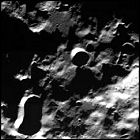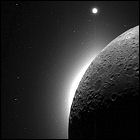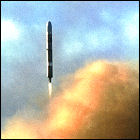What Clementine found
 Though its extended mission was cut short by a mishap in 1994, NASA’s ill-fated Clementine lunar orbiter returned data with significant implications for further manned visits to the moon. NASA announces that craters near the north and south poles of Earth’s moon may harbor enough water ice to allow long-term colonization, and could also be used to create propellant on-site. While this promising announcement occurs as the 30th anniversary of the first manned moon landing approaches, any further manned visits exist strictly on paper.
Though its extended mission was cut short by a mishap in 1994, NASA’s ill-fated Clementine lunar orbiter returned data with significant implications for further manned visits to the moon. NASA announces that craters near the north and south poles of Earth’s moon may harbor enough water ice to allow long-term colonization, and could also be used to create propellant on-site. While this promising announcement occurs as the 30th anniversary of the first manned moon landing approaches, any further manned visits exist strictly on paper.
Clementine goes off course
 NASA’s Clementine lunar orbiter, its moon mapping mission complete, is directed to fire its engines to put it on a trajectory for asteroid 1620 Geographos, a near-Earth asteroid named for the National Geographic Society (which sponsored a sky survey that led to its discovery). But one of Clementine’s thrusters stays on too long, firing for 11 minutes and revving the vehicle up to an unrecoverable spin of 80 revolutions per minute, exhausting its entire fuel supply in the process. Clementine’s secondary mission to Geographos is abandoned, and its batteries are exhausted a month later.
NASA’s Clementine lunar orbiter, its moon mapping mission complete, is directed to fire its engines to put it on a trajectory for asteroid 1620 Geographos, a near-Earth asteroid named for the National Geographic Society (which sponsored a sky survey that led to its discovery). But one of Clementine’s thrusters stays on too long, firing for 11 minutes and revving the vehicle up to an unrecoverable spin of 80 revolutions per minute, exhausting its entire fuel supply in the process. Clementine’s secondary mission to Geographos is abandoned, and its batteries are exhausted a month later.
Clementine lifts off
 NASA’s Clementine unmanned spacecraft is launched from Vandenberg Air Force Base toward Earth’s moon, the first American spacecraft to aim at that destination since the 1970s. Intended to map the moon with multispectral cameras and obtain a fresh gravity map, Clementine is a huge technological advance over NASA’s last lunar vehicle, featuring a 32-bit image processing system with solid state data storage. Clementine takes a leisurely trajectory to reach its destination, flying by Earth twice before reaching the moon a month after launch.
NASA’s Clementine unmanned spacecraft is launched from Vandenberg Air Force Base toward Earth’s moon, the first American spacecraft to aim at that destination since the 1970s. Intended to map the moon with multispectral cameras and obtain a fresh gravity map, Clementine is a huge technological advance over NASA’s last lunar vehicle, featuring a 32-bit image processing system with solid state data storage. Clementine takes a leisurely trajectory to reach its destination, flying by Earth twice before reaching the moon a month after launch.